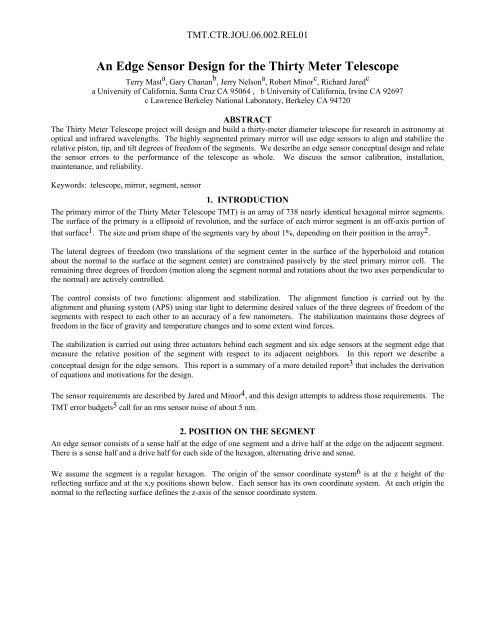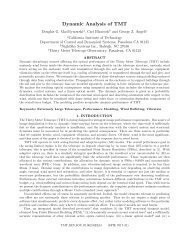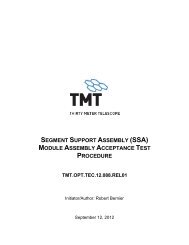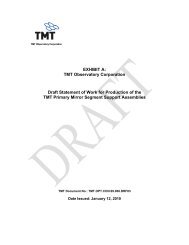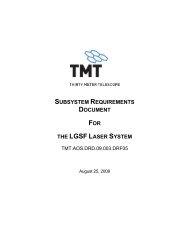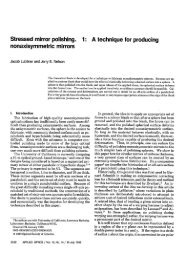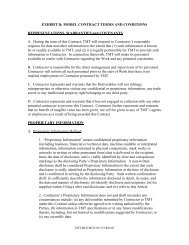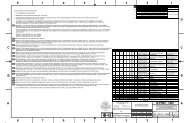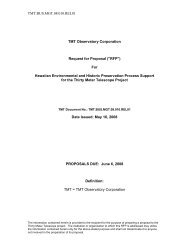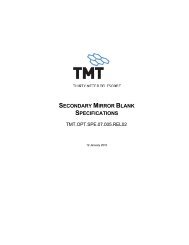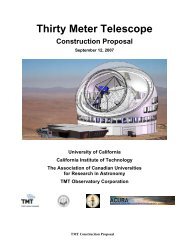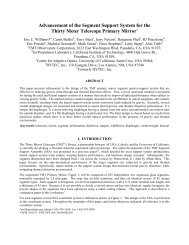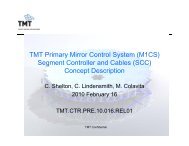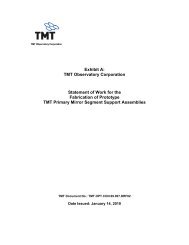An Edge Sensor Design for the TMT - Thirty Meter Telescope
An Edge Sensor Design for the TMT - Thirty Meter Telescope
An Edge Sensor Design for the TMT - Thirty Meter Telescope
Create successful ePaper yourself
Turn your PDF publications into a flip-book with our unique Google optimized e-Paper software.
<strong>TMT</strong>.CTR.JOU.06.002.REL01<br />
<strong>An</strong> <strong>Edge</strong> <strong>Sensor</strong> <strong>Design</strong> <strong>for</strong> <strong>the</strong> <strong>Thirty</strong> <strong>Meter</strong> <strong>Telescope</strong><br />
Terry Mast a , Gary Chanan b , Jerry Nelson a , Robert Minor c , Richard Jared c<br />
a University of Cali<strong>for</strong>nia, Santa Cruz CA 95064 , b University of Cali<strong>for</strong>nia, Irvine CA 92697<br />
c Lawrence Berkeley National Laboratory, Berkeley CA 94720<br />
ABSTRACT<br />
The <strong>Thirty</strong> <strong>Meter</strong> <strong>Telescope</strong> project will design and build a thirty-meter diameter telescope <strong>for</strong> research in astronomy at<br />
optical and infrared wavelengths. The highly segmented primary mirror will use edge sensors to align and stabilize <strong>the</strong><br />
relative piston, tip, and tilt degrees of freedom of <strong>the</strong> segments. We describe an edge sensor conceptual design and relate<br />
<strong>the</strong> sensor errors to <strong>the</strong> per<strong>for</strong>mance of <strong>the</strong> telescope as whole. We discuss <strong>the</strong> sensor calibration, installation,<br />
maintenance, and reliability.<br />
Keywords: telescope, mirror, segment, sensor<br />
1. INTRODUCTION<br />
The primary mirror of <strong>the</strong> <strong>Thirty</strong> <strong>Meter</strong> <strong>Telescope</strong> <strong>TMT</strong>) is an array of 738 nearly identical hexagonal mirror segments.<br />
The surface of <strong>the</strong> primary is a ellipsoid of revolution, and <strong>the</strong> surface of each mirror segment is an off-axis portion of<br />
that surface 1 . The size and prism shape of <strong>the</strong> segments vary by about 1%, depending on <strong>the</strong>ir position in <strong>the</strong> array 2 .<br />
The lateral degrees of freedom (two translations of <strong>the</strong> segment center in <strong>the</strong> surface of <strong>the</strong> hyperboloid and rotation<br />
about <strong>the</strong> normal to <strong>the</strong> surface at <strong>the</strong> segment center) are constrained passively by <strong>the</strong> steel primary mirror cell. The<br />
remaining three degrees of freedom (motion along <strong>the</strong> segment normal and rotations about <strong>the</strong> two axes perpendicular to<br />
<strong>the</strong> normal) are actively controlled.<br />
The control consists of two functions: alignment and stabilization. The alignment function is carried out by <strong>the</strong><br />
alignment and phasing system (APS) using star light to determine desired values of <strong>the</strong> three degrees of freedom of <strong>the</strong><br />
segments with respect to each o<strong>the</strong>r to an accuracy of a few nanometers. The stabilization maintains those degrees of<br />
freedom in <strong>the</strong> face of gravity and temperature changes and to some extent wind <strong>for</strong>ces.<br />
The stabilization is carried out using three actuators behind each segment and six edge sensors at <strong>the</strong> segment edge that<br />
measure <strong>the</strong> relative position of <strong>the</strong> segment with respect to its adjacent neighbors. In this report we describe a<br />
conceptual design <strong>for</strong> <strong>the</strong> edge sensors. This report is a summary of a more detailed report 3 that includes <strong>the</strong> derivation<br />
of equations and motivations <strong>for</strong> <strong>the</strong> design.<br />
The sensor requirements are described by Jared and Minor 4 , and this design attempts to address those requirements. The<br />
<strong>TMT</strong> error budgets 5 call <strong>for</strong> an rms sensor noise of about 5 nm.<br />
2. POSITION ON THE SEGMENT<br />
<strong>An</strong> edge sensor consists of a sense half at <strong>the</strong> edge of one segment and a drive half at <strong>the</strong> edge on <strong>the</strong> adjacent segment.<br />
There is a sense half and a drive half <strong>for</strong> each side of <strong>the</strong> hexagon, alternating drive and sense.<br />
We assume <strong>the</strong> segment is a regular hexagon. The origin of <strong>the</strong> sensor coordinate system 6 is at <strong>the</strong> z height of <strong>the</strong><br />
reflecting surface and at <strong>the</strong> x,y positions shown below. Each sensor has its own coordinate system. At each origin <strong>the</strong><br />
normal to <strong>the</strong> reflecting surface defines <strong>the</strong> z-axis of <strong>the</strong> sensor coordinate system.
<strong>TMT</strong>.CTR.JOU.06.002.REL01<br />
Exaggerated side view of two adjacent segments.<br />
Bold arrows are normals to <strong>the</strong> reflecting surface.<br />
The x axis is parallel to <strong>the</strong> hexagon side,<br />
and directions of positive x are shown below.<br />
y M1<br />
z SEN<br />
drive<br />
sense<br />
origin<br />
y SEN<br />
x M1<br />
The hexagon sides shown above are at <strong>the</strong> mid-planes of <strong>the</strong> inter-segment gaps.<br />
y drive sense<br />
M1<br />
y<br />
drive<br />
e<br />
sense<br />
β<br />
x M1<br />
The distance e is identical <strong>for</strong> all sensors and all segments. The angle β is given by<br />
<strong>the</strong> center-to-vertex distance of segment j.<br />
tan β = √3e/(2a j<br />
− e) ; where a j<br />
is<br />
3. OVERALL DESCRIPTION<br />
Each sensor uses a change in <strong>the</strong> charge on a capacitor to measure a linear combination of<br />
1) a change in <strong>the</strong> relative height (δz) of <strong>the</strong> two adjacent segments and<br />
2) a change in <strong>the</strong> dihedral angle (δω) between <strong>the</strong> two adjacent segments.<br />
z<br />
x<br />
sense<br />
plate<br />
drive plate 1<br />
Capacitor plates (not to scale).<br />
The sense plate is on one segment and <strong>the</strong> drive<br />
plates are on <strong>the</strong> o<strong>the</strong>r. Each half (drive or sense) is a<br />
single block of low <strong>the</strong>rmal expansion glass-ceramic<br />
plated with capacitor plates. Each block is attached<br />
to <strong>the</strong> back of a segment.<br />
drive plate 2
<strong>TMT</strong>.CTR.JOU.06.002.REL01<br />
4. SENSITIVITIES<br />
We describe <strong>the</strong> sensor sensitivity to all six degrees of freedom of one segment with respect to <strong>the</strong> adjacent segment;<br />
translations δx , δy , δz and rotations δθ x<br />
, δθ y<br />
, δθ z<br />
. For a simple capacitor C = Q/V = εA/g , where C = capacitance,<br />
Q = charge, V = voltage, ε = 8.85e −12 (farads/m), A = plate area, g = gap between plates.<br />
The proposed sensor geometry is shown below (not to scale).<br />
end view<br />
ω<br />
z<br />
y<br />
x<br />
side view<br />
segment<br />
h segment<br />
t<br />
L sensor<br />
drive plate a 1<br />
g 1<br />
g 2<br />
sense<br />
plate<br />
drive plate 2<br />
b 1<br />
2f<br />
b 2<br />
2B<br />
h block<br />
drive 1<br />
voltage<br />
drive 2<br />
voltage<br />
Center Line<br />
The basic concept is similar to <strong>the</strong> capacitive sensor used <strong>for</strong> <strong>the</strong> Keck telescopes; a vertical motion of one segment will<br />
increase one capacitance while decreasing <strong>the</strong> o<strong>the</strong>r. This will be highly linear in <strong>the</strong> displacement and dihedral angle<br />
changes <strong>for</strong> <strong>the</strong> small changes that will occur. We calculate <strong>the</strong> detailed geometry of <strong>the</strong> proposed <strong>TMT</strong> sensor design<br />
using <strong>the</strong> two simplifying assumptions.<br />
1. The capacitance is that of a simple capacitor in air. This is not strictly true since <strong>the</strong> glass-ceramic substrate<br />
has a dielectric constant. This reduces <strong>the</strong> capacitance by a factor up to about 2; calculated using <strong>the</strong> simulation code<br />
Maxwell. Consequently, to avoid this reduction we propose here to add ground planes to all sides of <strong>the</strong> sensor block<br />
with a 1 to 2 mm gap between <strong>the</strong> ground planes and active capacitor plates. Simulation of this configuration gives<br />
capacitances and sensitivities that agree within 1% of those calculated using <strong>the</strong> simple <strong>for</strong>mulas used above.<br />
2. The dielectric constant of <strong>the</strong> glass-ceramic substrate will enhance <strong>the</strong> coupled capacitance between <strong>the</strong> two<br />
drive plates. For <strong>the</strong> separation of <strong>the</strong> plates assumed below (4 mm) <strong>the</strong> coupled capacitance is small.<br />
Sensitivity to relative segment motions δz and δθ x<br />
(= δω)<br />
Although <strong>the</strong> design calls <strong>for</strong> symmetry in <strong>the</strong> plate dimensions, fabrication errors will result in small differences leading<br />
to non-zero values <strong>for</strong> Δ∆B, Δ∆ω, and ∆G defined as follows.<br />
Distances B and ∆B:<br />
b 1<br />
= B − f + (∆B + δz) and b 2<br />
= B − f − (∆B + δz))<br />
Dihedral angle between segments: ω = ∆ω + δω<br />
Distances G and ∆G:<br />
g 1<br />
= G + ∆G + (L sensor<br />
−f−b 1<br />
/2)(∆ω + δω)<br />
g 2<br />
= G + ∆G + (L sensor<br />
+f+b 2<br />
/2)(∆ω + δω)<br />
Drive voltages V and ∆V: V 1<br />
− V 2<br />
= 2V and V 1<br />
+ V 2<br />
= 2∆V<br />
The sensor reading R = Q 1<br />
+ Q 2<br />
= [2εaBV/G] [∆V/V + (∆B+δz)/B + (B+f)(∆ω+δω)/2G)]
<strong>TMT</strong>.CTR.JOU.06.002.REL01<br />
The alignment/phasing processes tune ∆V (= V offset<br />
) to achieve ∆V/V + ∆B/B + (B+f) ∆ω/2G) = 0<br />
Afterwards <strong>the</strong> segment stabilization system uses <strong>the</strong> reading change δR to move <strong>the</strong> segments to correct small non-zero<br />
values δz and δω.<br />
δR = [2εV/G] [ δz +(B(B+f)/(2G)) δω ]<br />
Define L effective<br />
= B(B+f)/(2G) ⇒ δR = [2εV/G] (δz + L effective<br />
δω)<br />
Sensitivity to δθ z<br />
A rotation about <strong>the</strong> z axis to first order will not change <strong>the</strong> average gap and will have no effect on <strong>the</strong> final charge<br />
developed on <strong>the</strong> sense plate. The next order effect is negligibly small (δC/C ~ 0.2 x 10 −10 ).<br />
Sensitivity to δθ y<br />
Consider <strong>the</strong> segment rotated about y, such that <strong>the</strong> o<strong>the</strong>r sensor on <strong>the</strong> same segment edge reads a maximum of it’s<br />
operating range. A calculation <strong>for</strong> our proposed sensor shows <strong>the</strong> false reading generated by this rotation is ~10 −14 m,<br />
negligibly small.<br />
Sensitivity to δx<br />
The drive plates are intentionally wider than <strong>the</strong> sense plate in order to make <strong>the</strong> output insensitive to small δx. Second<br />
order fringe-field effects are expected to cancel and only negligibly small third order fringe-field effects will contribute.<br />
A potentially significant δx sensitivity is created if a fabrication/installation error introduces a difference in θ y<br />
between<br />
<strong>the</strong> sense plate and <strong>the</strong> drive plates, θ y-d-s<br />
. Then a gravity-induced or temperature-induced change in x (δx) causes a<br />
reading change corresponding to δz false<br />
= δx θ y-d-s<br />
. Assume <strong>the</strong> sense plate has width = 30 m and is applied to an<br />
accuracy of 10 microns rms at <strong>the</strong> corners with respect to <strong>the</strong> block <strong>the</strong>n θ y-d-s<br />
= 0.010/15 = 7 x 10 −4 radians rms. If<br />
δx = 0.1 mm. ⇒ δz false<br />
= 70 nm rms. This is a large effect, and will be removed using a fit to all gap measurements to<br />
establish <strong>the</strong> value of δx to < 5 microns and a fit to temperature and zenith angle to refine this to δx to < 1 micron,<br />
resulting in δz false<br />
< 0.7 nm rms.<br />
Sensitivity to δy (= gap change = δG)<br />
Since <strong>the</strong> gap (G) will vary with gravity and temperature (resulting in changing <strong>the</strong> sensor output), we also need to<br />
measure G. We address below 1) <strong>the</strong> sensitivity to gap changes, 2) <strong>the</strong> expected size of <strong>the</strong> changes, 3) a method to<br />
measure <strong>the</strong> gap, and 4) <strong>the</strong> processing of <strong>the</strong> measurements. The gap measurement will be used to digitally correct <strong>the</strong><br />
reading δR.<br />
1) Sensitivity to gap changes. There are three ways a change in <strong>the</strong> gap (δG) affects <strong>the</strong> reading δR.<br />
• It changes <strong>the</strong> sensitivity to δz. δR/δz = 2εaV/G δ(δR/δz) = (δR/δz)(−δG/G)<br />
• It changes <strong>the</strong> sensitivity to δω δR/δω = 2εaVB(B+f)/(2G 2 ) δ(δR/δω) = (δR/δω)(−2δ/G)<br />
• It means <strong>the</strong> offset voltage is erroneous<br />
V offset<br />
= −V[∆B/B + (B+f)∆ω/(2G)] δV offset<br />
= −V(B+f)∆ω δG/(2G 2 )<br />
δR = 2εBδV offset<br />
/G = −2εVB(B+f)∆ω δG/(2G 3 )<br />
where ∆ω is <strong>the</strong> dihedral angle between segments after segment installation.<br />
In terms of a comparable δz δz = −B(B+f)∆ω δG/(2G 2 )<br />
2) Expected size of gap changes.<br />
Temperature-induced: If <strong>the</strong> cell temperature changes by 10 o C, <strong>the</strong>n δG = 125 microns.<br />
If we assume a rate of 1 o C per hour, <strong>the</strong>n δG/dt = 3.5 nm/second.
<strong>TMT</strong>.CTR.JOU.06.002.REL01<br />
Gravity-induced: If <strong>the</strong> primary mirror moves by ~10 mm, and we assume that 10%<br />
is differential, <strong>the</strong>n δG ~ 1mm/30m = ~ 30 microns.<br />
If this happens during a zenith to horizon slew in 2 minutes, <strong>the</strong>n δG/dt = 250 nm/second.<br />
We assume: • a maximum gap change of 150 microns ⇒ δG/G = 0.15/2.0 = 0.075<br />
• a maximum rate of 250 nm/second.<br />
Using <strong>the</strong>se values<br />
• Change in sensitivity to δz. δG/G = 0.075<br />
• Change in sensitivity to δω. 2δG/G = 0.15<br />
These changes in sensitivity (1.075 and 1.15) change <strong>the</strong> convergence rate of <strong>the</strong> segment stabilization control.<br />
However, <strong>the</strong>y are minor compared to gain of <strong>the</strong> control system (typically 0.2 to 0.1).<br />
• Erroneous offset voltage. In terms of a comparable δz, δz = −B(B+f) ∆ω δG/(2G 2 )<br />
⇒ We want δG/G < δz max<br />
2 G/[B(B+f)∆ω max<br />
]<br />
We want stability to δz < 3 nm. The δG/G limit <strong>the</strong>n depends on <strong>the</strong> installation error ∆ω max<br />
.<br />
For a maximum installation error ∆z max<br />
, <strong>the</strong> following diagram shows an extremely conservative estimate of<br />
∆ω max<br />
. The diagram assumes <strong>the</strong> extremely unlikely configuration with all four sensors at <strong>the</strong> maximum ∆z max<br />
.<br />
∆ω max<br />
= 2 ∆ max<br />
/1.04 m<br />
1.04 m<br />
If ∆ max<br />
=30 microns, <strong>the</strong>n ∆ω max<br />
= 6 x10 −5 radians. If B = 15 mm, f = 2 mm, G = 2 mm, <strong>the</strong>n δG/G < 1/1275.<br />
We require <strong>the</strong> gap to be measured to this level from one alignment/phasing procedure to <strong>the</strong> next; ~several weeks.<br />
3) Measuring <strong>the</strong> gap.<br />
The sensor electronics are described below. We will measure <strong>the</strong> gap by modifying at 20Hz <strong>the</strong> drive voltages <strong>for</strong> 1<br />
pulse of <strong>the</strong> 10 kHz square wave; equal to 2 of <strong>the</strong> 1000 charge pulses (both edges of <strong>the</strong> square wave give a charge<br />
pulse), and <strong>the</strong>n average <strong>the</strong> 2 pulses.<br />
+V<br />
V 1<br />
+V g<br />
V 2<br />
−V<br />
The modification will reverse <strong>the</strong> sign of V 2<br />
and reduce <strong>the</strong> voltage to V g<br />
= 1.0 V to prevent saturation.<br />
The reading during <strong>the</strong> gap measurement using a single pulse will be R = Q 1<br />
+ Q 2<br />
= εV g<br />
2(B−f)w/G.<br />
Assume B = 0.015 m, f = 0.002 m, w = 0.030 m, G = 0.002 m, ε = 8.85 x 10 -12 , V g = 1 volts. Then<br />
R = 3.5 x 10 -12 Coulombs = 2.2 x10 7 electrons, and averaging 2 charge pulses gives 4.4 x10 7 electrons. The error<br />
from electron statistics alone is δG/G = δR/R = 1/N 1/2 e = 1/9300. For <strong>the</strong> error from ADC bit size assume a signal<br />
of 2000 counts <strong>for</strong> <strong>the</strong> 2 mm gap, and assume <strong>the</strong> rms error <strong>for</strong> 1 LSB = 12 −1/2 = 0.29 ⇒ δG/G = 1/6900.<br />
Both of <strong>the</strong>se are smaller than our goal of 1/1275, thus averaging only two charge pulses is sufficient.<br />
4) Processing <strong>the</strong> Measurements<br />
We will use <strong>the</strong> local temperature (T), <strong>the</strong> elevation encoder reading (el), and <strong>the</strong> sensor gap measurement (G), to<br />
create a local sensor-by-sensor correction to <strong>the</strong> raw sensor reading.<br />
[We will also use <strong>the</strong> APS measurements, <strong>the</strong> gap measurements, <strong>the</strong> elevation encoder reading (el), and <strong>the</strong><br />
temperature measurements (T) to create a Global look-up table of desired sensor readings as a function of T<br />
and el.]<br />
+V g
<strong>TMT</strong>.CTR.JOU.06.002.REL01<br />
With 4212 gap measurements and (3*738−3) in-plane segment degrees of freedom, we are highly over constrained.<br />
We will make a fit to <strong>the</strong> ensemble of gap measurements to determine <strong>the</strong>ir consistency and <strong>the</strong> measurement error.<br />
We will use <strong>the</strong> fit to all gap measurements to establish <strong>the</strong> best estimate of <strong>the</strong> gap <strong>for</strong> each sensor and an estimate<br />
of <strong>the</strong> temperature of <strong>the</strong> mirror cell. Smooth functions of el and T will be fit to <strong>the</strong> measurements made at many<br />
values of el and T, and a correction <strong>for</strong> each sensor will be constructed from <strong>the</strong> fits. We expect <strong>the</strong> residuals to <strong>the</strong><br />
lookup tables will be random and thus correspond to random sensor noise. We want <strong>the</strong> residuals to be less than ~3<br />
nm rms.<br />
Temperature<br />
In addition to direct temperature measurements, we will also use <strong>the</strong> average gap measurement as a measure of <strong>the</strong><br />
average cell temperature. The lowest order effect of temperature is a uni<strong>for</strong>m change in <strong>the</strong> temperature of <strong>the</strong><br />
mirror cell. The gap change is <strong>the</strong> same <strong>for</strong> all gaps (uni<strong>for</strong>m expansion or contraction of <strong>the</strong> cell). Using <strong>the</strong><br />
average of all gap measurements we will create a highly precise lookup table versus temperature. The error of each<br />
sensor gap (σ G<br />
) can be made small by averaging over time. In addition, <strong>the</strong> error on <strong>the</strong> average over all sensors<br />
fur<strong>the</strong>r reduces <strong>the</strong> measure of this single mode: σ G<br />
/4212 1/2 = σ G<br />
/65 . If <strong>the</strong> sensor readings were not corrected <strong>for</strong><br />
this, <strong>the</strong>n <strong>the</strong> readings would be erroneously interpreted as a focus-mode de<strong>for</strong>mation of <strong>the</strong> primary mirror array.<br />
5. CAPACITOR PLATE DIMENSIONS<br />
Drive Plate <strong>Design</strong><br />
Width (w drive<br />
) To make <strong>the</strong> reading insensitive to motions along <strong>the</strong> x-axis (δx),<br />
we use a drive plate width that extends beyond <strong>the</strong> sense plate by 5 mm (see below).<br />
Height (h drive<br />
) To accommodate <strong>the</strong> sensor range in z and make <strong>the</strong> reading insensitive to rotations about <strong>the</strong> y-axis<br />
(δθ y<br />
), we use drive plate heights that are smaller than <strong>the</strong> sense plate by 3.0 mm (see below).<br />
Drive Plate Separation (2f) To maintain a small capacitive coupling between <strong>the</strong> two drive plates,<br />
we use a plate separation of 4 mm corresponding to f = 2 mm.<br />
Sense Plate <strong>Design</strong><br />
In <strong>the</strong> design calculations we have assumed <strong>the</strong> simple capacitance <strong>for</strong>mulas and assume ground planes surround <strong>the</strong><br />
capacitor plates. A simulation program “Maxwell” confirms <strong>the</strong> simple <strong>for</strong>mulas are accurate.<br />
Width (w sense<br />
)<br />
We compare <strong>the</strong> δz sensitivity with <strong>the</strong> sensors being used on <strong>the</strong> Keck telescopes.<br />
<strong>TMT</strong>/Keck = [w<br />
tmt<br />
sense<br />
V<br />
tmt /G<br />
tmt ] / [A<br />
keck V<br />
keck /(G<br />
keck )<br />
2 ]<br />
A keck = 30 x 30 = 900 mm 2 V keck = 6.74 volts G keck = 4 mm G tmt = 2 mm<br />
We propose here <strong>for</strong> <strong>the</strong> <strong>TMT</strong> w<br />
tmt<br />
sense<br />
= 30 mm, V<br />
tmt = 6 volts.<br />
<strong>TMT</strong>/Keck = ~1/4<br />
Height (h sense<br />
)<br />
control-stabilization :<br />
The maximum δz range is ~ 2 (a/t) act max<br />
,where a = 0. 6 m, t = 0.31 m, act max<br />
= 3.4 mm is <strong>the</strong> maximum<br />
actuator range maximum δz ~ 15 mm. However, Even if <strong>the</strong> sensors saturate <strong>the</strong> stabilization will converge.<br />
control-stabilization :<br />
This is dominated by <strong>the</strong> need to use focus-mode and three-color mode <strong>for</strong> alignment.<br />
Focus mode is “edge continuous” so it shouldn’t require δz motions. Three-color mode is used to<br />
• capture pistons <strong>for</strong> installation misalignment errors in sensor alignment lookup table (< 10 microns)<br />
Conclusion: The range must be perhaps a few times <strong>the</strong> offset range.
<strong>TMT</strong>.CTR.JOU.06.002.REL01<br />
sensitivity to dihedral angle δω.<br />
Assume G = 2 mm, B = 15 mm (h sense<br />
= 2B), f = 2 mm (plate separation = 4 mm)<br />
L effective<br />
= B(B+f)/(2G) ⇒ L effective<br />
= 63.8 mm<br />
5<br />
50<br />
5<br />
Mirror<br />
10<br />
mm<br />
dimensions in millimeters<br />
17.5<br />
Sense pad 30 x 30<br />
52 4<br />
30<br />
17.5<br />
mm<br />
Drive pads 17.5 x 40<br />
3<br />
50<br />
With <strong>the</strong>se dimensions <strong>the</strong> capacitance from <strong>the</strong> overlap with one drive plate is 1.73 pF.<br />
6. MECHANICAL DESIGN<br />
The sensor substrate is a rectangular block of glass-ceramic or ULE with dimensions in <strong>the</strong> table below.<br />
All sides are polished to relieve stress. All edges are beveled.<br />
Three raised feet on each block contact <strong>the</strong> shined spherical back of <strong>the</strong> segment. A rare earth magnet is bonded to <strong>the</strong><br />
block. This attracts a similar magnet bonded to <strong>the</strong> back of <strong>the</strong> segment and holds <strong>the</strong> block in position on <strong>the</strong> segment.<br />
The block may be positioned using nylon pins protruding from two blind holes drilled into <strong>the</strong> back of <strong>the</strong> segment. One<br />
pin seats in a blind hole in <strong>the</strong> block and <strong>the</strong> o<strong>the</strong>r rests against <strong>the</strong> edge of <strong>the</strong> block. Alternately, registration blocks<br />
attached to <strong>the</strong> mirror back may be used, thus eliminating <strong>the</strong> need <strong>for</strong> holes in <strong>the</strong> mirror.<br />
Three holes through <strong>the</strong> block thickness provide paths <strong>for</strong> wires to connect to <strong>the</strong> sense and power plates. Thus all<br />
electronics connect to <strong>the</strong> back of <strong>the</strong> sense block.<br />
A method to keep <strong>the</strong> gap isolated from dust, water, and water vapor is critical to <strong>the</strong> per<strong>for</strong>mance. We leave a space<br />
between <strong>the</strong> plate side of <strong>the</strong> block and <strong>the</strong> segment of 5 x 5 x 50 mm <strong>for</strong> a barrier we call <strong>the</strong> “gaiter”. A flexible torus<br />
of material can be inserted through <strong>the</strong> gap and connected around each block in this space. The figure below illustrates<br />
<strong>the</strong> concept.
<strong>TMT</strong>.CTR.JOU.06.002.REL01<br />
A collapsed gaiter might be stored on one block of one<br />
side of <strong>the</strong> sensor <strong>for</strong> segment installation, and <strong>the</strong>n <strong>for</strong><br />
segment use it might be deployed across <strong>the</strong> gap ei<strong>the</strong>r<br />
manually or using air pressure or an electromagnet. <strong>An</strong><br />
explicit design is remains to be created.<br />
The mechanical dimensions follow.<br />
Each Block Sense Block (mm)<br />
dimensions (mm) feed through hole (1)<br />
length (along edge of segment) 50 diameter 2<br />
depth (extending behind segment) 45 sense plate<br />
(boot space 5, capacitor space 40) Z height 30<br />
thickness 20 X length 30<br />
(15 mm at boot space)<br />
edge bevels (12) 0.3<br />
feet (3)<br />
length 4<br />
widths (2) 2<br />
width (1) 4<br />
height 1<br />
hole <strong>for</strong> rare earth magnets<br />
diameter 10 Drive Block (mm)<br />
depth 7 feed through holes (2)<br />
hole <strong>for</strong> positioning pin diameter 2<br />
diameter 3 drive plates (2)<br />
Z height 17.5<br />
X length 40<br />
block volume (m^3)<br />
4.5E-05<br />
block mass (kg) 0.114<br />
Comments.<br />
Feet (3): The compression induced by <strong>the</strong> magnet <strong>for</strong>ce will not compress <strong>the</strong> feet to match <strong>the</strong> curved segment<br />
surface. The feet must be polished on a curved tool (radius ~ 60 m) to seat properly.<br />
In addition, <strong>the</strong> feet heights must match <strong>the</strong> spherical surface slope and <strong>the</strong> normal at <strong>the</strong> gap <strong>for</strong> <strong>the</strong> block to be<br />
at an angle such that <strong>the</strong> gap is uni<strong>for</strong>m. The spherical surface slope at <strong>the</strong> edge is ~a/k = 0.6/60, and over <strong>the</strong><br />
block thickness (20 mm) gives a difference in feet height of 200 microns. The nominal height is 1 mm, but <strong>the</strong><br />
actual heights must provide this 200 micron difference.<br />
Surfaces: all are fine ground<br />
Capacitor plates: coating: 0.5 microns of gold over 0.05 microns of chrome<br />
Magnets: rare earth magnets: minimum required <strong>for</strong>ce ~ 15 X sensor mass = 1.5 kg ~ 15 N<br />
We assume two magnet pairs/block with each magnet <strong>for</strong> a total of (2)(12)(738)(7/6) = 20,700 magnets.
<strong>TMT</strong>.CTR.JOU.06.002.REL01<br />
segment back surface<br />
boot<br />
space<br />
front view<br />
end view<br />
blind hole<br />
through hole<br />
<strong>for</strong> wire to<br />
sense plate<br />
sense<br />
plate<br />
blind hole<br />
top view<br />
rare earth<br />
magnets<br />
positioning<br />
rods<br />
7. ELECTRONICS (DESIGN, RANGE, LINEARITY)<br />
<strong>Design</strong><br />
The next three drawings show an initial design of <strong>the</strong> proposed sensor electronics.<br />
The sensor is connected to <strong>the</strong> Pre-Amplifier by a coax cable (0.3 to 0.6 m long). The electronics at <strong>the</strong> sensor fit on a 50<br />
x 50 mm board that is permanently attached to <strong>the</strong> segment.<br />
• Readout at 20 Hz has 1000 ADC data samples:<br />
998 samples are summed to measure position/tilt and 2 samples are used to measure <strong>the</strong> gap.<br />
Both numbers are read at 20 Hz.<br />
• The gap calibration pulse is used to obtain <strong>the</strong> ADC value <strong>for</strong> a gap of 2 mm.<br />
• In “Fast Data Capture” mode <strong>the</strong> sensor is read at 400Hz, is locally stored and readout at a later time.
<strong>TMT</strong>.CTR.JOU.06.002.REL01<br />
Electronics Overview<br />
<strong>Sensor</strong> 1 of 6 shown<br />
Mirror <strong>Sensor</strong> Electronics 1 of 123<br />
<strong>Sensor</strong><br />
Connector<br />
<strong>for</strong> drives 6 ea.<br />
A B C<br />
<strong>Sensor</strong><br />
Charge<br />
Electronics<br />
at<br />
<strong>Sensor</strong><br />
contains:<br />
Preamp<br />
Shaper Amp<br />
Driver<br />
Goal 300 mw<br />
Position<br />
and Tilt<br />
<strong>Sensor</strong> <strong>An</strong>alog<br />
Gap Calib Pulse<br />
DC Power<br />
Gap<br />
Connector<br />
6 PreAmps<br />
Electronics<br />
at<br />
Mirror<br />
Support <strong>for</strong> 6<br />
sensors<br />
contains:<br />
6 ADCs<br />
6 DAC sets<br />
1 FPGA<br />
<strong>Sensor</strong> data<br />
Oscillator<br />
Sync<br />
Read/write<br />
Drive 1<br />
Drive 2<br />
Connector<br />
6 drive<br />
sets<br />
Electronics at <strong>Sensor</strong><br />
Pre-Amplifier<br />
RC(CR)2 Shaping Amplifier<br />
~ 4 micro-seconds Cable driver<br />
A<br />
B<br />
<strong>Sensor</strong> <strong>An</strong>alog<br />
<strong>Sensor</strong><br />
Charge<br />
Calibrated Capacitor<br />
+/- 6 V DC to all<br />
DC Power<br />
Gap Calib Pulse
<strong>TMT</strong>.CTR.JOU.06.002.REL01<br />
Electronics at Mirror<br />
B<br />
<strong>Sensor</strong> <strong>An</strong>alog<br />
6 ea <strong>Sensor</strong> Support, BLC and ADC<br />
ADC 16bit<br />
DC Power<br />
ADC & BLC Timing<br />
Gap Calib Pulse 6 ea<br />
6 ea <strong>Sensor</strong> Drive Generation<br />
6 set SW<br />
Gap<br />
Drive 1 6 ea<br />
Gap Calib DAC<br />
1 ea<br />
Gap DAC 1 ea<br />
Offset DAC 6 ea<br />
0.1 VGMax<br />
to –0.1 VGMax<br />
R/W<br />
R/W<br />
R/W<br />
FPGA Contains:<br />
1 Generation of<br />
Switch Control<br />
<strong>for</strong> position/tilt, gap, &<br />
gap calibration<br />
2 R/W to DACs<br />
3 Generation of 10kHz<br />
4 Timing of ADC<br />
5 Integration of all pulses<br />
in 20 Hz readout period<br />
6 Capture & integration of<br />
fast data stream (400Hz)<br />
7 Readout of sensor<br />
position/tilt and gap data<br />
8 Readout out of gap<br />
calibration pulse<br />
C<br />
<strong>Sensor</strong> data<br />
Oscillator<br />
Sync<br />
Read/write<br />
Drive 2<br />
Position<br />
and Tilt<br />
6 ea<br />
Gain DAC 1 ea<br />
0 to VGMax<br />
Switch Control<br />
R/W<br />
DC Power<br />
Range<br />
Using standard fixtures we will measure <strong>the</strong> position of <strong>the</strong> plates with respect to <strong>the</strong> reflecting surface after each sensor<br />
is attached to <strong>the</strong> segment. The initial offset voltages will be determined using <strong>the</strong>se measurements. We assume <strong>the</strong> rms<br />
measurement error is 10 microns. To accommodate measurement errors and allow <strong>the</strong> phasing measurement to<br />
“capture” all segments, we assume <strong>the</strong> electronics requires a full range (in possibly a “coarse” mode) of ±30 microns.<br />
Linearity<br />
We assume <strong>the</strong> non-linearity to be dominated by <strong>the</strong> non-linearity in <strong>the</strong> final ADC. Non-linearity caused by fringe fields<br />
and substrate dielectric constant is negligible. Commercial ADC’s with 16 bits advertise a non-linearity of
<strong>TMT</strong>.CTR.JOU.06.002.REL01<br />
8. SENSOR NOISE<br />
We assume a square wave pulse rate of 10kHz. We assume <strong>the</strong> averaging rate <strong>for</strong> segment stabilization will be 20 Hz<br />
(giving (10kHz*2)/20 Hz = 1000 charge pulses per average) and <strong>for</strong> diagnostics (called “fast data capture “ mode at<br />
Keck) will be 400 Hz (giving 50 pulses per average).<br />
For segment stabilization, <strong>the</strong> telescope error budget calls <strong>for</strong> a sensor electronic noise corresponding to ~3 nm rms δz.<br />
For δz = 3 nm, δC = 0.273pf/mm from Maxwell simulations and V = 6V, <strong>the</strong> charge from a single 3 nm pulse is<br />
δQ = δCV = 31 electrons.<br />
The noise will be dominated by noise in <strong>the</strong> pre-amp, and we have determined using both simulation and calculation a<br />
noise of 90 electrons rms <strong>for</strong> each charge pulse. Since alternate pulses have opposite signs, <strong>the</strong> base line is removed, and<br />
<strong>the</strong> signals from 1000 pulses are added. The signal-to-noise ratio is S/N = (3 1electrons * 1000)/(90 electrons * 1000 ½ )<br />
= 11 corresponding to 0.3 nm rms. The Keck sensor electronics noise is < 1 nm rms 7 .<br />
9. SENSOR NOISE PROPAGATION TO PRIMARY MIRROR<br />
A detailed description of <strong>the</strong> effect of sensor noise on <strong>the</strong> shape of <strong>the</strong> full primary mirror is given in Reference 3.<br />
A fundamental result is<br />
80%ΕΕ = σ s<br />
[0.0065] with 80%ΕΕ in arc seconds on <strong>the</strong> sky and σ s<br />
in nm<br />
The <strong>TMT</strong> error budget calls <strong>for</strong> 80%ΕΕ < 0.030 arc seconds, requiring σ s<br />
< 4.6 nm. This gives rms surface S rms<br />
= 58<br />
nm and rms wavefront W rms<br />
= 116 nm. The implication of this value <strong>for</strong> <strong>the</strong> sensor requirements depends on <strong>the</strong> <strong>TMT</strong><br />
control bandwidth. If we assume a bandwidth (BW) = 0.3 Hz and a white noise spectrum, <strong>the</strong>n <strong>the</strong> required sensor noise<br />
(S noise<br />
) is given by 8<br />
S noise<br />
= σ s<br />
/[(π/2) BW] 1/2 yielding S noise<br />
< 6.7 nm/√Hz 1/2<br />
10. POSITION SENSITIVITY<br />
We assume <strong>the</strong> magnets will hold <strong>the</strong> sensor in position during operations. The following are <strong>the</strong> tolerances <strong>for</strong><br />
installation of <strong>the</strong> block on <strong>the</strong> back of <strong>the</strong> segment.<br />
Δx < ± 0.5 mm To not add fringe field effects to capacitances<br />
Δy < ± 0.1 mm To not significantly change <strong>the</strong> gap<br />
Δz < ± 0.03 mm<br />
Δθ x<br />
< ± 3.0e-3 rad (0.2mm/66mm) To not require too large an offset ΔG<br />
Δθ y<br />
< ± 2.5e-3 rad (0.5mm/200 mm) To not add fringe field effects<br />
Δθ z<br />
< ± 5.0e-4 rad (0.1mm/200 mm) To not add fringe field effects<br />
11. GRAVITY SENSITIVITY<br />
Gravity changes from zenith to horizon will change <strong>the</strong> sensor reading, resulting in relative motions of <strong>the</strong> sense and<br />
drive blocks, in two ways:<br />
• de<strong>for</strong>mation of <strong>the</strong> segments<br />
• bending and tilt of <strong>the</strong> sensor<br />
A priori we expect <strong>the</strong> first to dominate, since <strong>the</strong> drive and sensor block will move under lateral gravity in opposite<br />
directions. We expect <strong>the</strong> bending and tilt of <strong>the</strong> sensors to be in <strong>the</strong> same direction canceling <strong>the</strong> effect on <strong>the</strong> sensor<br />
reading.<br />
De<strong>for</strong>mation of <strong>the</strong> Segments: Axial gravity<br />
The axial component of gravity acting on <strong>the</strong> sensor blocks will de<strong>for</strong>m <strong>the</strong> segment. To first order, this will be<br />
corrected by re-optimizing <strong>the</strong> positions of <strong>the</strong> whiffletree/segment attachment points. <strong>An</strong>y residuals will be corrected at
<strong>TMT</strong>.CTR.JOU.06.002.REL01<br />
<strong>the</strong> zenith using ion figuring. This will result in a surface de<strong>for</strong>mation as <strong>the</strong> zenith angle increases. However <strong>the</strong><br />
overall error budget increases with zenith angle, and this particular term can increase substantially. We anticipate that<br />
his axial gravity term will readily meet <strong>the</strong> error budget.<br />
De<strong>for</strong>mation of <strong>the</strong> Segments: Lateral gravity<br />
Because <strong>the</strong> sensors extend in back of <strong>the</strong> segment, lateral gravity will induce a moment on <strong>the</strong> edges of <strong>the</strong> segments.<br />
Relative motions of <strong>the</strong> sensor blocks will be in <strong>the</strong> same direction in <strong>the</strong> plane of <strong>the</strong> segments, but in opposite<br />
directions normal to <strong>the</strong> segments.<br />
g<br />
We will make a finite element calculation to estimate <strong>the</strong> magnitude of this effect. However, it will be removed using<br />
<strong>the</strong> APS-generated lookup table (a function of zenith angle). In addition, <strong>the</strong> error budget allows <strong>the</strong> error to increase<br />
substantially with increasing zenith angle. The residual error from <strong>the</strong> lookup table will make a negligible contribution<br />
to <strong>the</strong> error budget.<br />
Bending and tilt of <strong>the</strong> sensor<br />
Under gravity loads in <strong>the</strong> x and y directions <strong>the</strong> body will bend and <strong>the</strong> feet will compress. Since <strong>the</strong> drive and sense<br />
halves are identical, <strong>the</strong> effects will cancel and have a negligible effect on <strong>the</strong> reading. In addition, if <strong>the</strong>re is any<br />
residual effect, it will be smoo<strong>the</strong>d with a fit to a function of elevation angle and be removed in <strong>the</strong> APS-generated<br />
lookup table.<br />
We have calculated <strong>the</strong> magnitude of <strong>the</strong> bending and tilting effects that will be cancelled. The sensor bending under its<br />
own weight is <strong>for</strong> gravity in <strong>the</strong> x and y direction is 0.3 and 2.2 nm respectively.<br />
At elevation angle = 0 <strong>the</strong> sensor will tilt since <strong>the</strong> <strong>for</strong>ce on one foot will increase (δF) and on <strong>the</strong> o<strong>the</strong>r decrease (−δF).<br />
Balancing <strong>the</strong> moment gives a maximum displacement of 10.2 nm. The <strong>for</strong>ce applied to each foot by <strong>the</strong> magnet is<br />
about 15 times <strong>the</strong> sensor weight; F axial<br />
= 0.114 (9.8) 15 / 2 = 8.4 N<br />
At <strong>the</strong> horizon, <strong>the</strong> <strong>for</strong>ce on <strong>the</strong> upper foot is reduced by 1.8 N (~20%) and <strong>the</strong> <strong>for</strong>ce on <strong>the</strong> lower foot is increased by 1.8<br />
N. The friction between <strong>the</strong> feet and <strong>the</strong> segment must be adequate to prevent creep motion of <strong>the</strong> sensor as <strong>the</strong><br />
telescope is repeatedly moved over a large range in zenith angle.<br />
12. TEMERATURE SENSITIVITY<br />
The mechanical sensor is made of low <strong>the</strong>rmal expansion glass ceramic with a CTE that will closely match <strong>the</strong> CTE of<br />
<strong>the</strong> segment. Small differences in CTE might lead to a sensitivity up to ~10 nm/ o C, and this will be removed by<br />
calibration. The residual will not contribute significantly to <strong>the</strong> temperature sensitivity. The temperature sensitivity of<br />
<strong>the</strong> readout electronics depends on <strong>the</strong> selection of components. As a guide, <strong>the</strong> rms temperature sensitivity of <strong>the</strong> Keck<br />
sensors 7 is about 0.3nm/ o C.<br />
13. HUMIDITY SENSITIVITY<br />
We do not yet have a definitive understanding of capacitive sensor sensitivity to humidity.<br />
• Observers at Keck have never suggested that <strong>the</strong> humidity degrades <strong>the</strong> per<strong>for</strong>mance.<br />
• Recent laboratory tests of a Keck sensor show a sensitivity to humidity that depends on <strong>the</strong> nature of <strong>the</strong><br />
process used to clean <strong>the</strong> gold surfaces. Gold has a high free surface energy, and it condenses water with a low free<br />
energy surface. Gabor Somoraji (UC Berkeley) has suggested <strong>the</strong> possibility of coating <strong>the</strong> gold with a hydrocarbon or<br />
Teflon, and we will investigate this possibility.
<strong>TMT</strong>.CTR.JOU.06.002.REL01<br />
14. POWER<br />
Our goal is to have <strong>the</strong> power radiated by each sensor and its electronics to be < 300 mW. In addition, we require that<br />
<strong>the</strong> electronics/software allow a complete recovery from a power loss of <strong>the</strong> settings at <strong>the</strong> time of <strong>the</strong> loss. A full<br />
electronics design is being created to meet <strong>the</strong>se requirements.<br />
15. DRIFT WITH TIME<br />
The sensors are required to not drift during <strong>the</strong> periods between segment alignment/phasing procedures, roughly every<br />
six weeks.<br />
In addition, since we will want to use <strong>the</strong> array as soon after segment exchange as possible, we have set a goal <strong>for</strong> <strong>the</strong> full<br />
sensor system to settle to its final value in less than four hours. We expect that during segment exchange <strong>the</strong> mechanical<br />
part of <strong>the</strong> sensor will have been undisturbed from many hours and will have a very small settling time. The electronics<br />
should be largely insensitive to temperature, and we also expect a small settling time.<br />
16. MAINTENANCE<br />
There are three categories of activity that will affect <strong>the</strong> sensor reading and require a calibration using <strong>the</strong> APS.<br />
1. <strong>Sensor</strong> removal and replacement<br />
2. Segment surface cleaning<br />
3. Segment removal, coating, and replacement<br />
1. <strong>Sensor</strong> removal and replacement<br />
The exchange of a sense block, drive block, or <strong>the</strong> electronics <strong>for</strong> a sensor will require one or more measurements by<br />
<strong>the</strong> APS to re-establish <strong>the</strong> desired sensor reading.<br />
2. Segment surface cleaning<br />
The cleaning of a segment surface with CO 2<br />
or o<strong>the</strong>r agents can potentially affect a sensor reading. This will<br />
require APS measurements to confirm <strong>the</strong> segment cleaning process does not affect <strong>the</strong> desired sensor reading. If<br />
<strong>the</strong> cleaning process has been repeatedly shown to not affect <strong>the</strong> reading, <strong>the</strong> use of <strong>the</strong> APS after cleaning can be<br />
discontinued.<br />
3. Segment removal, coating, and replacement<br />
The effect of <strong>the</strong> sensor on <strong>the</strong> coating chamber and <strong>the</strong> effect of <strong>the</strong> coating process on <strong>the</strong> sensor need to be<br />
thoroughly proven and understood. Potential concerns include <strong>the</strong> heat generated by <strong>the</strong> segment coating process,<br />
out-gassing of ei<strong>the</strong>r <strong>the</strong> sensor or <strong>the</strong> segment and it’s support, and changes in <strong>the</strong> sensor’s gold coating.<br />
Removal and replacement of a segment will change <strong>the</strong> gap (∆G). This alone will require measurements by <strong>the</strong> APS<br />
to re-define <strong>the</strong> desired sensor reading.<br />
Removal and replacement of a segment will change <strong>the</strong> values of ∆z and ∆ω. A database of matching drive block<br />
and sense block serial numbers may be used to improve <strong>the</strong> efficiency of APS measurements.<br />
17. RELIABILITY<br />
The piston, tip, and tilt degrees of freedom of <strong>the</strong> 738 segments are actively controlled by 2214 actuators and 4212<br />
sensors. Thus <strong>the</strong>re is extensive redundancy in <strong>the</strong> sensor measurements. At any one time many sensors could be<br />
deleted from <strong>the</strong> system, and <strong>the</strong> stabilization per<strong>for</strong>mance would not significantly degrade. The Keck telescopes<br />
typically operate with several sensors deleted from <strong>the</strong> control algorithm.<br />
ACKNOWLEDGEMENTS<br />
The authors gratefully acknowledge <strong>the</strong> support of <strong>the</strong> <strong>TMT</strong> partner institutions. They are <strong>the</strong> Association of Canadian<br />
Universities <strong>for</strong> Research in Astronomy (ACURA), <strong>the</strong> Association of Universities <strong>for</strong> Research in Astronomy (AURA),<br />
<strong>the</strong> Cali<strong>for</strong>nia Institute of Technology and <strong>the</strong> University of Cali<strong>for</strong>nia. This work was supported, as well, by <strong>the</strong> Canada<br />
Foundation <strong>for</strong> Innovation, <strong>the</strong> Gordon and Betty Moore Foundation, <strong>the</strong> National Optical Astronomy Observatory,<br />
which is operated by AURA under cooperative agreement with <strong>the</strong> National Science Foundation, <strong>the</strong> Ontario Ministry of<br />
Research and Innovation, and <strong>the</strong> National Research Council of Canada.
<strong>TMT</strong>.CTR.JOU.06.002.REL01<br />
REFERENCES<br />
The central archive of <strong>TMT</strong> documents (Docushare) is at tmt.org. <strong>TMT</strong> Reports and Technical notes are available at<br />
tmt.ucolick.org<br />
1. Mast, T., J. Nelson, and G. Sommargren, “Primary Mirror Segment Fabrication <strong>for</strong> CELT”, <strong>TMT</strong> Report No. 5,<br />
Proceedings of <strong>the</strong> SPIE, 4003 (June 2000), document archive Docushare CEL.OPT.JOU.00.001.REL01<br />
2. Mast, T. and J. Nelson. “<strong>TMT</strong> Primary Mirror Segment Shape” <strong>TMT</strong> Report No. 58 (November 2004) document<br />
archive Docushare <strong>TMT</strong>.OPT.TEC.04.001.REL01<br />
3. Mast, T., Gary Chanan, Jerry Nelson, Robert Minor, Richard Jared “<strong>An</strong> <strong>Edge</strong> <strong>Sensor</strong> <strong>Design</strong> <strong>for</strong> <strong>the</strong> <strong>TMT</strong>” <strong>TMT</strong><br />
Report No. 70 March 2006<br />
4. Jared, Richard and Robert Minor, “<strong>TMT</strong> Position and Tilt <strong>Sensor</strong> Requirements” document archive Docushare<br />
<strong>TMT</strong>.SEN.SPE.05.001.REL02 (October 2005)<br />
5. Mast, T. and J. Nelson , “Image Size and Wavefront Error Budgets” <strong>TMT</strong> Report No. 10, document archive<br />
Docushare <strong>TMT</strong>.OPT.TEC.05.024(,025, and 026).DRF01)<br />
6. Mast, Terry , George <strong>An</strong>geli, and Scott Roberts “<strong>TMT</strong> Coordinate Systems”, <strong>TMT</strong> Report No 67, document archive<br />
Docushare <strong>TMT</strong>.SEN.TEC.05.016.DRF04 (2005)<br />
7. Jackson, H.G. and T. T. Shimizu, (Position <strong>Sensor</strong> Electronics <strong>for</strong> <strong>the</strong> Ten <strong>Meter</strong> <strong>Telescope</strong>), Keck Observatory<br />
Technical Note No. 224 (April 1987) (LBL-23383)<br />
8. MacMartin and Chanan, Control of <strong>the</strong> Cali<strong>for</strong>nia Extremely Large <strong>Telescope</strong> Primary Mirror,<br />
<strong>TMT</strong> Report No. 40, 2002, <strong>TMT</strong> document archive Docushare CEL.CTR.TEC.02.001.REL01


